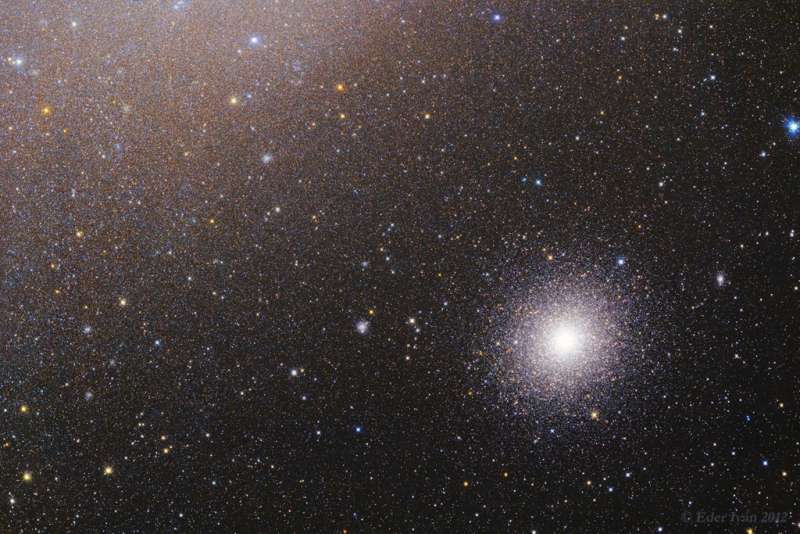Credit & Copyright: Ivan Eder
Explanation:
Globular star cluster 47 Tucanae is a jewel of the southern sky.
Also known
as NGC 104, it roams
the halo of our Milky Way Galaxy
along with around 200 other globular star clusters.
The second brightest globular cluster (after
Omega Centauri)
as seen from planet Earth, it lies about 13,000 light-years away and
can be spotted naked-eye near the
Small Magellanic Cloud (SMC)
in the constellation of
the Toucan.
Of course, the SMC is some 210,000 light-years
distant, a satellite galaxy of our Milky Way and not physically close
to 47 Tuc.
Stars on the outskirts of the SMC are seen at the upper left of
this
broad southern skyscape.
Toward the lower right with about the same
apparent diameter as a Full
Moon, dense cluster 47 Tuc is made up of several million
stars in a
volume
only about 120 light-years across.
Away from the bright cluster core,
the red giants
of 47 Tuc are easy to pick out as yellowish tinted stars.
Globular cluster 47 Tuc is also home to exotic
x-ray binary star systems.
1999 2000 2001 2002 2003 2004 2005 2006 2007 2008 2009 2010 2011 2012 2013 2014 2015 2016 2017 2018 2019 2020 2021 2022 2023 2024 2025 |
Yanvar' Fevral' Mart Aprel' Mai Iyun' Iyul' Avgust Sentyabr' Oktyabr' Noyabr' Dekabr' |
NASA Web Site Statements, Warnings, and Disclaimers
NASA Official: Jay Norris. Specific rights apply.
A service of: LHEA at NASA / GSFC
& Michigan Tech. U.
|
Publikacii s klyuchevymi slovami:
47 Tuc - 47 Tukana - Sharovoe skoplenie - Maloe Magellanovo Oblako
Publikacii so slovami: 47 Tuc - 47 Tukana - Sharovoe skoplenie - Maloe Magellanovo Oblako | |
Sm. takzhe:
Vse publikacii na tu zhe temu >> | |
